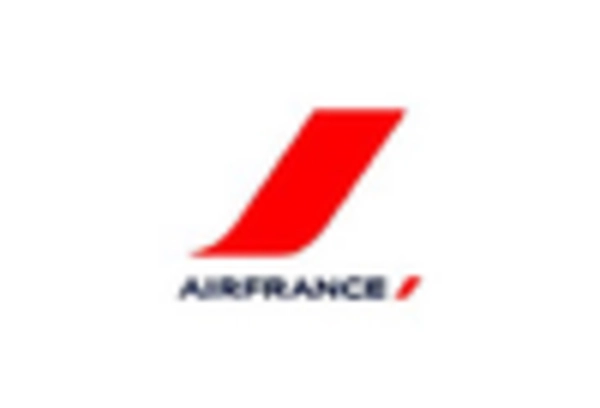Evolving Consumer Preferences
The airline ancillary-services market is experiencing a shift in consumer preferences, with travelers increasingly seeking personalized and tailored experiences. This trend is driven by a growing demand for convenience and comfort during air travel. According to recent data, approximately 70% of travelers express a willingness to pay for additional services that enhance their journey, such as priority boarding and extra legroom. As airlines adapt to these evolving preferences, they are likely to expand their ancillary offerings, thereby increasing revenue streams. The focus on customer satisfaction and loyalty is paramount, as airlines strive to differentiate themselves in a competitive landscape. This evolving consumer behavior is expected to significantly influence the airline ancillary-services market, prompting airlines to innovate and diversify their service portfolios to meet the expectations of modern travelers.
Regulatory Changes and Compliance
The airline ancillary-services market is subject to various regulatory changes that can impact service offerings and pricing structures. Recent regulations aimed at enhancing consumer protection and transparency in pricing have prompted airlines to reevaluate their ancillary service strategies. For instance, the introduction of mandatory disclosures regarding fees for services such as baggage and seat selection has led to a more informed consumer base. This regulatory environment may compel airlines to adjust their pricing models, potentially increasing the overall revenue generated from ancillary services. Compliance with these regulations is crucial, as failure to adhere could result in penalties and damage to brand reputation. Consequently, airlines are likely to invest in systems and processes that ensure compliance while optimizing their ancillary service offerings in the airline ancillary-services market.
Competitive Landscape and Market Dynamics
The competitive landscape of the airline ancillary-services market is characterized by a diverse array of players, including low-cost carriers and traditional airlines. This competition drives innovation and service differentiation, as airlines seek to capture market share and enhance customer loyalty. Recent data indicates that ancillary revenue accounted for approximately 10% of total airline revenue in the US, underscoring the importance of these services in overall business strategies. As airlines compete for travelers' attention, they are likely to introduce new and unique ancillary offerings, such as bundled services and loyalty programs. This dynamic environment compels airlines to continuously assess their service portfolios and adapt to changing market conditions, ultimately shaping the future trajectory of the airline ancillary-services market.
Economic Factors Influencing Travel Behavior
Economic factors play a crucial role in influencing consumer behavior within the airline ancillary-services market. Fluctuations in disposable income, fuel prices, and overall economic conditions can impact travelers' willingness to spend on ancillary services. For instance, during periods of economic growth, consumers may be more inclined to purchase additional services, such as premium seating and extra baggage allowances. Conversely, economic downturns may lead to a more price-sensitive consumer base, prompting airlines to adjust their ancillary service pricing strategies. Recent trends suggest that as the economy stabilizes, there is a potential for increased spending on ancillary services, which could bolster revenue for airlines. Understanding these economic dynamics is essential for airlines aiming to optimize their ancillary service offerings in the airline ancillary-services market.
Technological Advancements in Service Delivery
Technological advancements are playing a pivotal role in shaping the airline ancillary-services market. Innovations such as mobile applications, artificial intelligence, and data analytics are enhancing the efficiency and effectiveness of service delivery. Airlines are increasingly leveraging technology to streamline the booking process for ancillary services, allowing customers to easily select and purchase options such as in-flight meals and Wi-Fi access. Data analytics enables airlines to better understand customer preferences, leading to more targeted marketing strategies. As a result, airlines that effectively integrate technology into their ancillary service offerings may experience increased customer engagement and higher revenue. The ongoing evolution of technology in the airline ancillary-services market suggests a future where seamless service delivery becomes the norm, further driving growth in this sector.

















Leave a Comment